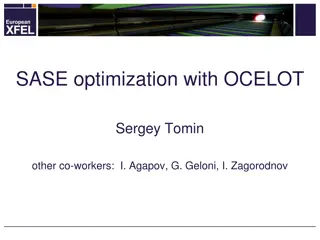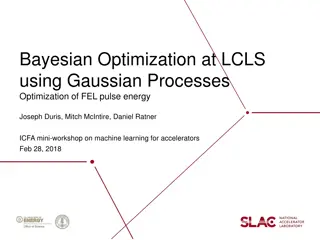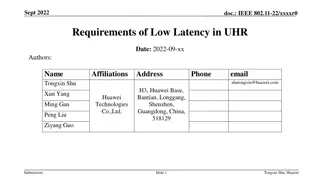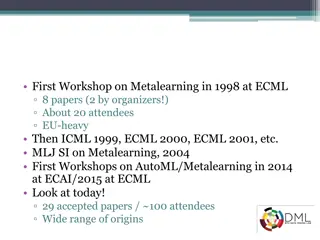Machine Learning Optimization for HTTP Latency Tuning on NGINX
Exploration of machine learning optimization algorithms for enhancing HTTP latency tuning on NGINX. The study investigates the use of ML tuning as a superior alternative to manual methods, focusing on operating system tuning, existing methods, and future autotuning work. Key areas covered include memory management, CPU and I/O scheduling, NUMA considerations, TCP buffer configurations, memory swapping, and Sysctl parameters. The goal is to achieve low latency while balancing high throughput.
Uploaded on Sep 20, 2024 | 0 Views
Download Presentation

Please find below an Image/Link to download the presentation.
The content on the website is provided AS IS for your information and personal use only. It may not be sold, licensed, or shared on other websites without obtaining consent from the author. Download presentation by click this link. If you encounter any issues during the download, it is possible that the publisher has removed the file from their server.
E N D
Presentation Transcript
Exploration of Machine Learning Optimization Algorithms in HTTP Latency Tuning on NGINX Krzysztof Sywula krz.sywula@bytedance.com Jasmine Mou jasmine.mou@bytedance.com System Technologies and Engineering, ByteDance
Problem Statement Operating system tuning for better overall performance of NGINX 2
Agenda Example of NGINX proxy scenario running various workloads Existing methods of NGINX and OS tuning Machine learning tuning as better alternative to manual tuning Machine learning tuning experiment with 16 specific sysctl parameters Future Autotuning work 3
NGINX reverse proxy clients backend servers 4
Existing methods of tuning Involve expert knowledge Static and permanent tuning Not scalable 5
What is the goal of the tuning? Low latency vs high throughput 6
Areas to look into Memory Management CPU scheduling Networking I/O scheduling 7
CPU scheduling Choose the scheduling algorithm Configure scheduling parameters Some even deploy custom scheduler 8
To NUMA or not to NUMA May want to avoid NUMA for low latency applications 9
Read and Write TCP buffers How many, what size? 10
Memory swapping Best to disable to achieve very best performance but not always feasible 11
Sysctl has over 1000 parameters to tune! 12
Can machine learning algorithm determine the best configuration? 13
Can all those parameters be adjusted dynamically? 14
Our machine learning tuning attempt Experiment design Goal/Metric to evaluate: HTTP Latency Parameters to tune: 16 sysctl parameters selected from 4 domains 1.Memory Management: swappiness, vfs_cache_pressure, dirty_ratio, min_slab_ratio, min_unmapped_ratio. 2.CPU Scheduler: sched_latency_ns, sched_min_granularity_ns, sched_wakeup_granularity_ns. 3.Networking: tcp_reordering, tcp_limit_output_bytes, tcp_notsent_lowat, tcp_min_tso_segs. 4.Block I/O: fifo_batch, read_expire, write_expire, writes_starved. 15
Our machine learning tuning attempt Experiment design Optimization algorithm: Bayesian Optimization Recipe: 1.start with initial set of observed values. 2.create a surrogate function. 3.get the acquisition function. 4.choose the highest point (maximal problem). 5.find the value of the highest point. 6.repeat 1 to 5. 16
Our machine learning tuning attempt Experiment setup Benchmarking tool: wrk (wrk -t12 -c200 -d30s --latency http://address/index.html). for each batch: run wrk for 30 seconds, and collect p99 value to represent the result from this batch. run 30 batches and get 30 p99 values. final metric formula: HTTP latency = mean + ? x std. dev. ?=0.1 Results analysis: we keep the min value as the final result. values are not constant, but distribution consistency can be observed, whether it's average value or p99. 17 Legend: Default Parameter Set Parameter Set 1 Parameter Set 2
Our machine learning tuning attempt Experiment Results Run Time per data point (approx.) Min. HTTP Latency (ms) Percentage Improvement No. Description Comments 1 Manual Testing (37) NA 30 min 2.66 Baseline 2 Acquisition Function = UCB 17 min 2.97 -11.6 % Acquisition Function = POI With prior knowledge 3 17 min 2.57 3.4 % Acquisition Function = UCB With prior knowledge 4 17 min 2.46 7.5 % Auto Tuning with Bayesian Optimization Acquisition Function = EI With prior knowledge 5 17 min 2.44 8.2 % Acquisition Function = EI With prior knowledge Better handling integer nature 6 17-20 min 2.34 12 % 18 Check p.24 for optimization results of parameter values
Our machine learning tuning attempt Animation of tuning process final_animation.mp4 19
Our machine learning tuning attempt Fine tuning tricks Prior knowledge from kernel SMEs: With 16 parameters and huge range sets it becomes difficult for bayesian to converge soon. So we took inputs from kernel SME s on parameter ranges. Ex: range of sched_latency_ns is from 1200000 to 24000000 --instead of using all the values we use only increments of 1200000. Different acquisition function settings After prior knowledge we also explored different acquisition functions in the bayesian optimization: UCB (Upper Confidence Bound) EI (Expected Improvement) POI (Probability of Improvement) 20
Our machine learning tuning attempt Observations & findings 1.Manual testing may not give fully optimal performance. 2.More parameters, more time to tune. 3.Prior knowledge will contribute to better performance. 4.Dynamic tuning vs static one-time tuning: Static tuning: time-independent: objective function does not vary with respect to time. lower computation cost. Dynamic tuning: time-dependent: when environment variables are also dynamically changing. 21
Future work TCP Congestion Control algorithm choice. TCP Congestion Control settings. Configure memory thresholds tcp_rmem and tcp_wmem to prevent packet dropping. Configure TCP buffer sizes rmem_max and wmem_max. Test other optimization algorithms over different workloads. 22
Appendix. Optimization Results Kernel parameters Parameter values Kernel parameters Parameter values sched_latency_ns 18000000 min_slab_ratio 12 sched_min_granularity_ns 14400000 min_unmapped_ratio 5 sched_wakeup_granularity_ns 2500000 swappiness 0 tcp_limit_output_bytes 5259264 vfs_cache_pressure 80 tcp_min_tso_segs 12 fifo_batch 4 tcp_notsent_lowat 2108751872 read_expire 300 tcp_reordering 5 write_expire 1000 dirty_ratio 28 writes_starved 4 24

























